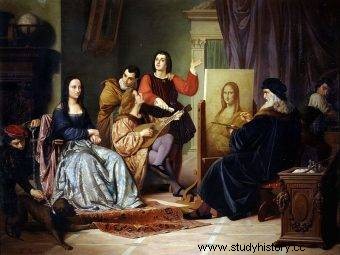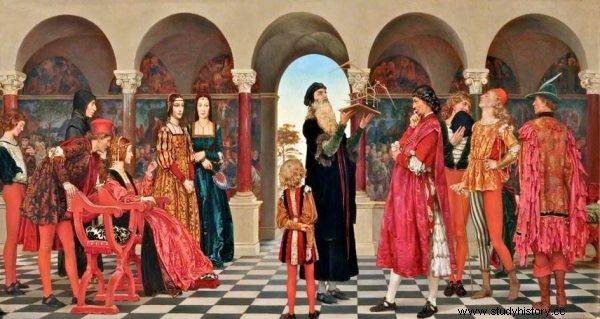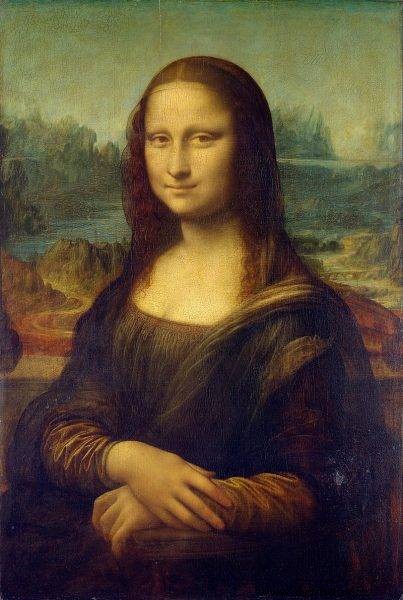This is one of the most famous - and mysterious paintings in the history of the world. What are the secrets of Leonardo da Vinci's enigmatic Mona Lisa smile?
Her head is reaching the end of time, her eyelids are a bit tired. It is a beauty that flows from within and is imprinted on the body - a treasury, in each of its cells, of strange thoughts, fantastic digressions and wonderful passions ... (Walter Pater, 1839–1894, English writer and art critic).
There are countless citations describing the beauty of the Louvre portrait in Paris. Already in the 16th century, La Gioconda was considered an exceptional picture - even perfect. Walking through the corridors of the Louvre, we pass a lot of other works of Leonardo - Madonna among the rocks or St. Anna Samotrzenie - but this is the Mona Lisa he is the one who draws the audience the most.

There are countless citations describing the beauty of the Louvre portrait in Paris. Already in the 16th century, La Gioconda was considered an exceptional painting - even perfect.
There is always a huge queue of people in front of him who, for a moment, want to see the most famous work of the Italian Renaissance (or at least!) With their own eyes (although the barriers separating the audience from the painting are set quite far away, in addition, seeing the details of the master's subtle technique makes it difficult also armored glass and an old dark yellow varnish (the original colors of the original may be reproduced by the so-called Prado copy; probably painted by one of the master's students during the creation of Mona Lisa ).
A man without education
Leonardo di ser Piero da Vinci was born on April 15, 1452 in the Tuscan village of Anchiano (near Vinci) as the illegitimate child of Pier da Vinci and a young girl named Caterina (or Catarina), whom little is known about. It was probably a local peasant, the orphan Caterina di Meo Lippi.
We also know little about Leonardo's youth - he himself did not mention this period very willingly in his writings. His illegitimate background made it difficult for him to obtain university education, as well as to continue the family tradition - becomes a lawyer. By the way - such conditions concerned mainly the middle class, aristocratic bastards easily received education, high offices and wealth and did not have to worry about inferior social position, as was the case with the lower-born.

Leonardo considered himself an uneducated man (uomo senza lettere), which could simply mean a lack of a good command of Latin.
Leonardo considered himself an uneducated man ( uomo senza lettere ), which could simply mean a lack of a good command of Latin. After the family moved to Florence, the future master began studying at the workshop of the famous painter and goldsmith Andrea del Verrocchio in the late 1660s. Leonard's father did not spare on his education.
It is worth mentioning that Verrocchio was interested in many fields - art, music, mathematics and engineering - which undoubtedly must have impressed the young student. In 1472 Leonardo was enrolled in the brotherhood of St. Łukasz, associating local artists . Over time, he became a collaborator in Verrocchia's studio and assisted the master in carrying out orders.
Job Application
In 1483 he moved to the capital of Lombardy - Milan. He immediately sent a letter to Ludovico Sforza with an offer of work that he could do for the court (it was mainly engineering work related to the army!). There were also artistic ventures that the young painter could undertake. Employment at court gave him financial stability, continuity of orders, his own service and helpers, as well as an exclusive vineyard.
Leonardo used the opportunities offered by court life: he met other artists, trained, performed various orders, played instruments, directed plays, designed clothes etc. Ludovico Sforza wanted Milan (like Florence) to become a city full of art and outstanding artists.

Ludovico Sforza wanted Milan (like Florence) to become a city full of art and outstanding artists.
Leonardo's life can be divided into several periods; The 1st Florentine and Milan Periods, the 2nd Florentine and Milanese Periods, the Roman Period (in which he devoted himself to a better understanding of medicine - first on human corpses, which led to a conflict with Pope Leo X of the time, and later on animals) and the French Period when it became became a royal architect and lived in the Manoir de Cloux, located near the royal residence in Amboise. In the last years of his life, his patron became Francis I - the ruler of France.
The most famous woman in the world
Mona Lisa ( La Gioconda ) came from his brush in the Second Florentine period. Leonardo da Vinci painted a picture of the most famous woman in the world for about four years (1503–1507). The wife of the Florentine merchant Francesco del Giocondo - Lisa née Gherardini - smiles mysteriously from the poplar plank.
It is amazing that this painting never landed in the hand of the commissioner (Leonardo owned it for the rest of his life). Could the Florentine merchant not be able to pay for the portrait he had made? Or maybe Leonardo did not want to sell the painting because he saw in it the most perfect work he could create? A work that was a reflection of his work and studies on mother nature and innovative painting technique.
Did the person depicted in it contribute to the splendor and fame of the painting at all? However, it seems more likely that it is the way Leonardo painted the Mona Lisa. The woman is sitting in the loggias (a kind of covered balcony). You can see fragments of the balustrade at the elbows and two columns supporting the roof. In the background there is a beautiful landscape, which was probably invented by the master - unusual rock formations and cliffs, lakes, a river with a bridge over its current and a dry stream bed. This view was presented from a "bird's eye view", which emphasized the depth and eliminated the apparent transitions between elements.

Leonardo da Vinci painted a picture of the most famous woman in the world for about four years (1503–1507).
Leonardo used the sfurmato technique when painting a model that is, multiple application of very thin layers of paint in order to make the dark elements of the image unnoticeably turn into the light ones, creating the illusion of foggy and smooth penetration. Back then it was an innovation, so the painting evoked a lot of emotions from the very beginning.
Its great popularity and the multitude of (sometimes strange and absurd) conspiracy theories circulating around it are the aftermath of the nineteenth-century love of art as a result of opening the French royal collections to a wider audience (the Louvre Museum has become publicly available). They wondered what had caused the model's lips to slightly lift - was it a flirtatious smile or a forced and insincere smile? Was the woman paralyzed on one side of her face? In effect, the character of Mona Lisa has been shrouded in scientifically unsubstantiated speculations, which is also echoing in popular culture.
The fate of the painting
Leonardo da Vinci died on May 2, 1519. In his will, he handed over Mona Lisa to his student, Giacomo Caprotti (also known as Salai). Later the painting ended up in the hands of Leonardo's sisters; they sold it to the French king - Francis I. Originally hung in the royal residence in Fontainebleau. During the reign of Louis XIV, he was transferred to Versailles, to finally end up in the Louvre. Calm Mona Lisie disrupted Napoleon Bonaparte, who took her and placed her in his bedroom in a palace in the contemporary Tuilerie district of Paris. After the emperor was sent to the island of St. Helen's portrait was returned to the Louvre in 1815.
In August 1911, he disappeared from it for the second time. This time La Gioconda has been stolen. After the work was finished, on the evening of August 20, Vincenzo Peruggia - a painter employed at the Louvre - decided to hide, wait out the night and in the morning take the painting out of the museum (the Louvre was supposed to be closed that day). Then Peruggia went to his apartment in Paris and there he hid a masterpiece pulled out of the frame. After two years of Mona Lisa was transported to Florence. There, Vincenzo tried to sell it by contacting the local owner of the art gallery - Alfredo Geri. This informed the director of the excellent Uffizi Gallery, Giovanni Poggi, who confirmed the authenticity of the portrait. The case was reported to the police.
After being found, the painting was returned to the Louvre in 1913. The perpetrator of the theft was sentenced to over a year in prison, but finally regained his freedom after seven months. The motives for the theft were supposedly strictly patriotic - Vincenzo Peruggia wanted to bring Mona Lisa to his native country - her, his and the famous author.
